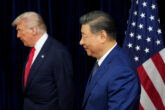March 28, 2023
Agile Ukraine, Lumbering Russia: The Promise and Limits of Military Adaptation
During more than 13 months of war against one of the world’s largest armies, Ukraine’s military has continually stood out for one quality in particular: its ability to adapt. Over and over, Ukraine has nimbly responded to changing battlefield dynamics and exploited emerging technologies to capitalize on Russia’s mistakes. Despite their limited experience with advanced weapons technology, Ukrainian soldiers quickly graduated from point-and-shoot Javelin and Stinger missile systems to the more sophisticated High Mobility Artillery Rocket System (HIMARS), which they have used to pummel Russian command centers, logistical assets, and ammunition depots. They have deployed military and commercial drones in increasingly creative ways. And although this is not the first war to play out on social media, the Ukrainians have been giving the world a master class in effective information operations in the digital age. Such is their record of technical and tactical versatility that Ukrainian forces continue to enjoy a sense of momentum, despite the fact that the frontlines have been largely frozen for months.
Unlike its enemy, Ukraine has been able to learn from and respond to unexpected and shifting battlefield conditions.
By contrast, Russian forces have shown limited openness to new tactics or new technologies. Hobbled by bad leadership and terrible morale, the Russian military was slow to recover from its disastrous attempt to seize Kyiv in February 2022 and has struggled to adjust its strategy or learn from its mistakes. This is despite having demonstrated considerable dexterity in its deployments in eastern Ukraine in 2014 and in Syria starting in 2015. In the current war, although Russian military leaders have made some adjustments to alleviate logistical problems and improve coordination on the ground, the Kremlin’s core strategy continues to rely largely on throwing more manpower and firepower at the enemy—a lumbering, high-cost approach that has hardly inspired confidence. Observing this performance, some Western experts have raised the possibility of exceedingly dire scenarios, including a doomed Russian spring offensive, a large-scale mutiny of troops, or even the collapse of Russian President Vladimir Putin’s regime.
Read the full article from Foreign Affairs.
More from CNAS
-
Transatlantic Security / Technology & National Security
Look Before We Leap on Artificial IntelligenceThis article was originally published on The Dispatch. A debate about the role that artificial intelligence should and will play in society, and how it will affect humanity fo...
By Jon B. Wolfsthal
-
Technology & National Security
Caleb Withers on the Cybersecurity Frontier in the Age of AICaleb Withers, research associate at the Center for a New American Security, joins Kevin Frazier, the AI Innovation and Law Fellow at the University of Texas School of Law and...
By Caleb Withers
-
Technology & National Security
Prepared, Not ParalyzedExecutive Summary The Trump administration has embraced a pro-innovation approach to artificial intelligence (AI) policy. Its AI Action Plan, released July 2025, underscores t...
By Janet Egan, Spencer Michaels & Caleb Withers
-
Indo-Pacific Security / Technology & National Security
Sharper: Tech + ChinaRecent talks between President Donald Trump and Chinese Communist Party General Secretary Xi Jinping placed a spotlight on emerging technologies, from high-end chips to minera...
By Charles Horn & Sevi Silvia




